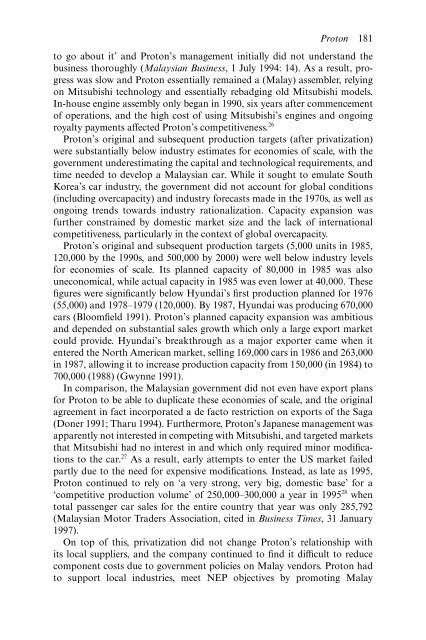PRIVATIZATION Privatization in Malaysia, Regulation, rent-seeking and policy failure
PRIVATIZATION Privatization in Malaysia, Regulation, rent-seeking and policy failure
PRIVATIZATION Privatization in Malaysia, Regulation, rent-seeking and policy failure
You also want an ePaper? Increase the reach of your titles
YUMPU automatically turns print PDFs into web optimized ePapers that Google loves.
Proton 181to go about it’ <strong>and</strong> Proton’s management <strong>in</strong>itially did not underst<strong>and</strong> thebus<strong>in</strong>ess thoroughly (<strong>Malaysia</strong>n Bus<strong>in</strong>ess, 1 July 1994: 14). As a result, progresswas slow <strong>and</strong> Proton essentially rema<strong>in</strong>ed a (Malay) assembler, rely<strong>in</strong>gon Mitsubishi technology <strong>and</strong> essentially rebadg<strong>in</strong>g old Mitsubishi models.In-house eng<strong>in</strong>e assembly only began <strong>in</strong> 1990, six years after commencementof operations, <strong>and</strong> the high cost of us<strong>in</strong>g Mitsubishi’s eng<strong>in</strong>es <strong>and</strong> ongo<strong>in</strong>groyalty payments affected Proton’s competitiveness. 26Proton’s orig<strong>in</strong>al <strong>and</strong> subsequent production targets (after privatization)were substantially below <strong>in</strong>dustry estimates for economies of scale, with thegovernment underestimat<strong>in</strong>g the capital <strong>and</strong> technological requirements, <strong>and</strong>time needed to develop a <strong>Malaysia</strong>n car. While it sought to emulate SouthKorea’s car <strong>in</strong>dustry, the government did not account for global conditions(<strong>in</strong>clud<strong>in</strong>g overcapacity) <strong>and</strong> <strong>in</strong>dustry forecasts made <strong>in</strong> the 1970s, as well asongo<strong>in</strong>g trends towards <strong>in</strong>dustry rationalization. Capacity expansion wasfurther constra<strong>in</strong>ed by domestic market size <strong>and</strong> the lack of <strong>in</strong>ternationalcompetitiveness, particularly <strong>in</strong> the context of global overcapacity.Proton’s orig<strong>in</strong>al <strong>and</strong> subsequent production targets (5,000 units <strong>in</strong> 1985,120,000 by the 1990s, <strong>and</strong> 500,000 by 2000) were well below <strong>in</strong>dustry levelsfor economies of scale. Its planned capacity of 80,000 <strong>in</strong> 1985 was alsouneconomical, while actual capacity <strong>in</strong> 1985 was even lower at 40,000. Thesefigures were significantly below Hyundai’s first production planned for 1976(55,000) <strong>and</strong> 1978–1979 (120,000). By 1987, Hyundai was produc<strong>in</strong>g 670,000cars (Bloomfield 1991). Proton’s planned capacity expansion was ambitious<strong>and</strong> depended on substantial sales growth which only a large export marketcould provide. Hyundai’s breakthrough as a major exporter came when itentered the North American market, sell<strong>in</strong>g 169,000 cars <strong>in</strong> 1986 <strong>and</strong> 263,000<strong>in</strong> 1987, allow<strong>in</strong>g it to <strong>in</strong>crease production capacity from 150,000 (<strong>in</strong> 1984) to700,000 (1988) (Gwynne 1991).In comparison, the <strong>Malaysia</strong>n government did not even have export plansfor Proton to be able to duplicate these economies of scale, <strong>and</strong> the orig<strong>in</strong>alagreement <strong>in</strong> fact <strong>in</strong>corporated a de facto restriction on exports of the Saga(Doner 1991; Tharu 1994). Furthermore, Proton’s Japanese management wasappa<strong>rent</strong>ly not <strong>in</strong>terested <strong>in</strong> compet<strong>in</strong>g with Mitsubishi, <strong>and</strong> targeted marketsthat Mitsubishi had no <strong>in</strong>terest <strong>in</strong> <strong>and</strong> which only required m<strong>in</strong>or modificationsto the car. 27 As a result, early attempts to enter the US market failedpartly due to the need for expensive modifications. Instead, as late as 1995,Proton cont<strong>in</strong>ued to rely on ‘a very strong, very big, domestic base’ for a‘competitive production volume’ of 250,000–300,000 a year <strong>in</strong> 1995 28 whentotal passenger car sales for the entire country that year was only 285,792(<strong>Malaysia</strong>n Motor Traders Association, cited <strong>in</strong> Bus<strong>in</strong>ess Times, 31 January1997).On top of this, privatization did not change Proton’s relationship withits local suppliers, <strong>and</strong> the company cont<strong>in</strong>ued to f<strong>in</strong>d it difficult to reducecomponent costs due to government policies on Malay vendors. Proton hadto support local <strong>in</strong>dustries, meet NEP objectives by promot<strong>in</strong>g Malay


